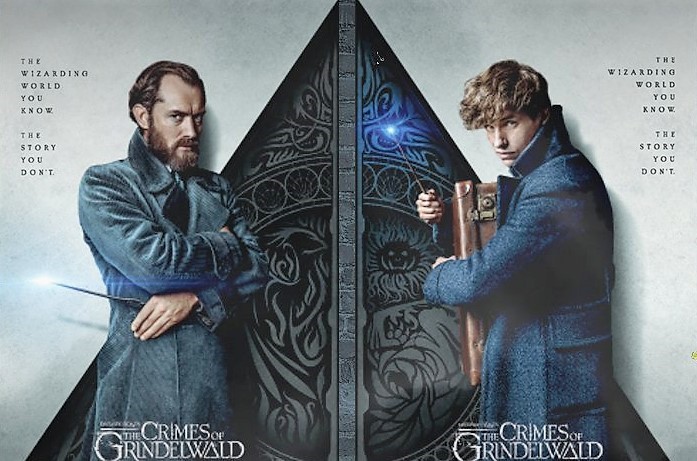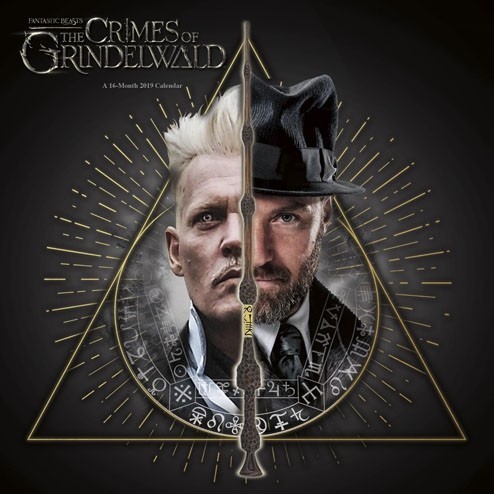The Alchemical Symbolism of the Deathly Hallows in “Crimes of Grindelwald”
This is the final article in a three-part series in which Dr. Beatrice Groves explores the origins of the Deathly Hallows symbol. In her first post, Dr. Groves established a link between Harry Potter and “The Man Who Would Be King.” In her second post, she analyzed the Masonic inspiration behind the symbol of the Hallows. In this third post, Dr. Groves, building upon John Granger’s work, links alchemical and Masonic symbolism to argue for one further, startling, connection between Harry Potter and the Deathly Hallows and “The Man Who Would Be King.”
by Dr. Beatrice Groves
John Granger’s work – in both his Unlocking Harry Potter (2007) and Deathly Hallows Lectures (2008) – has shown how alchemy has shaped the Deathly Hallows.
In this alchemical image (with thanks to John Granger), we can see how closely allied the Masonic symbol from “The Man Who Would Be King” (an interlocking pair of compasses and set square with an eye at its center) is to this alchemical symbol (an interlocking pair of compasses and set square with a circle at its center). Alchemy and Freemasonry are, in fact, closely allied modes of thought. Both revolve around self-purification through a secret and arcane quest. Both rely strongly on the power of symbols: a pictorial device that encompasses a complete concept (which, the skeptic might note, can easily suggest themselves as a shortcut to profundity). The square and compasses that we see in this alchemical image are (literally) the tools of a Mason, and in Masonic symbolism, as in alchemical symbolism, point to the idea of God as the one who unites heaven and earth as the “Great Architect of the Universe.”
It is even possible, given this overlapping symbolism, that Rowling has underlined the Masonic origins of her symbol in order to throw us off the scent of how important its alchemical side will be. The first recorded English Freemason was Elias Ashmole (who remains celebrated to this day as the founder of Oxford’s Ashmolean Museum). But Ashmole was also highly interested in alchemy, as the Dictionary of National Biography notes:
In 1650, under the pseudonym James Hasolle, he brought out Fasciculus chemicus, a translation of two Latin alchemical works, one of them by Arthur Dee, son of the famous Elizabethan magus John Dee. Then, in 1652, he brought out his great Theatrum chemicum Britannicum, a collection of alchemical poems in English designed to supplement the massive European Theatrum chemicum (1602 and subsequent editions) and to draw attention to English achievements in the field. Ashmole put much effort into collecting together, and annotating these texts and his book remains one of the key sources for the history of alchemy, putting into print numerous works that had previously existed solely in manuscript.
Fascinatingly, Ashmole even believed himself to hold the key to the creation of the philosopher’s stone:
He prided himself on his place in the oral tradition of alchemical secrets. In the early 1650s he refers to himself as a pupil of the adept William Backhouse, and in 1653 he notes that Backhouse, ill and thought to be close to death, passed on to him the secret of the philosopher’s stone. Later there are indications that he in turn passed on such secrets to Robert Plot, first keeper of the Ashmolean.
Nicolas Flamel – the wizarding world’s creator of the Philosopher’s Stone (a historical figure who was – inaccurately – reputed to be an alchemist) – is, of course, going to be making a major return in Fantastic Beasts: The Crimes of Grindelwald.
There are two types of alchemy – the literal (or “exoteric”) search for a real stone that will bring eternal life and endless gold, and the mystical (or “esoteric”) version of the quest, in which the stone and elixir are metaphors for spiritual riches of the eternal life hereafter. In one of the circles of the Harry Potter series, the explicitly alchemical quest for the Philosopher’s Stone of the first novel is reflected by the more esoteric version of the alchemical search for spiritual enlightenment in the Hallows quest of the final novel.
Rowling has always spoken of Harry’s journey as a quest. On Pottermore, likewise, Rowling has written of Harry’s wand wood (holly) that it chooses wizards who are on a “spiritual quest.” Rowling has noted the way in which Harry “has to be this questing person… a hero is often slightly set apart, not so much inhuman as a purified form of a human, they are the one who must fulfill the quest” – and her use of the word “purified” here is a strikingly alchemical one. In the final novel, Harry will have been tried in the fires of adversity and found to be true gold (remember how “essence of Harry” – in the Polyjuice Potion – does indeed turn out to be the color of gold?!). Within the novels, this aspect of Harry’s story is only fully revealed in the final novel – in which the journey he is on is first explicitly spoken of as a quest: “You’ve got to find out about them for yourself! It’s a Quest” (DH, ch. 22).
The Hallows quest is introduced in an explicitly alchemical context. As John Granger has shown, Bill and Fleur’s wedding is symbolically marked as an “alchemical wedding” (a crucial stage in the creation of the philosopher’s stone), in which the warring chemical elements of sulfur and mercury are united.
Bill and Fleur’s wedding not only unites a silver-haired bride (wearing a moonstone tiara) to her red-headed husband but also sees Luna (“moon”) arrive dressed in dazzlingly bright, yellow sun colors. Xenophilius’s gold Hallows necklace, indeed, forms part of the Lovegoods’ festive sun colors; hence, it partakes in the wedding’s alchemical uniting of the contraries of cool, silvery mercury and fiery, gold sulfur.
But there is also another, very subtle, link of the Hallows quest with alchemy. As Rowling acknowledged in 2007, “The Tale of the Three Brothers” is directly inspired by Chaucer’s “The Pardoner’s Tale.” In both tales, three “brothers” meet Death and are tempted by desirable objects. In Chaucer’s tale, what the three brothers desire is a pile of gold. But Harry Potter recasts the moral of “The Pardoner’s Tale” and changes a story about the perils of greed into a meditation on the right response to death. Harry Potter argues that an ability to face one’s own mortality is the ultimate power over death. In an alchemical transformation, the gold of Chaucer’s tale becomes the true acceptance of mortality in the Hallows quest.
Gold and Death in “The Man Who Would Be King”
Chaucer places a biblical verse radix malorum est Cupiditas (“greed is the root of all evil”) as the epigraph of his story and Rowling writes a similar admonitory verse over Gringotts’ “piles of wizard gold” (SS, ch. 5):
Enter, stranger, but take heed
Of what awaits the sin of greed,
For those who take, but do not earn,
Must pay most dearly in their turn.
So if you seek beneath our floors
A treasure that was never yours,
Thief, you have been warned, beware
Of finding more than treasure there.
When Harry first visits Gringotts, to find himself the unwitting inheritor of a vast pile of gold, he hears this warning about death for those who search for treasure that is not theirs. It is a warning he remembers when, in Harry Potter and the Deathly Hallows, he returns to search for another vault full of gold, and to steal from it. And in this final treasure vault, he finds an object – besides the golden Horcrux – that links gold and death. And forms one final, startling, link with “The Man Who Would Be King.”
The Lestranges’ vault in Gringotts is a treasure cave like that to which Peachy and Danny are taken in “The Man Who Would Be King.” Both are caves stuffed to overflowing with gold coins, golden vessels, and rubies (the ones in the film are as outsized as the “pile of rubies as big as glowing coals” (SS, ch. 5) that Harry sees on his first visit to Gringotts). The Lestrange vault is described as “a cavelike opening crammed from floor to ceiling with golden coins and goblets, silver armor, the skins of strange creatures – some with long spines, others with drooping wings – potions in jeweled flasks, and a skull still wearing a crown” (DH, ch. 26). This final object – though easily overlooked – is one of the most gothic objects of the entire series – a head that has withered away to bone, without relinquishing its crown. Who puts a crown in their treasure vault without first removing the skull it sits on? (Bellatrix, clearly.) This macabre crown is yet another hint as to the form the “final” Horcrux – the diadem Horcrux – will take. But this crowned skull also finds an astonishingly vivid parallel with the closing shot of “The Man Who Would Be King” – a shot that underlines its story as a kind of alchemical morality tale.
The Masonic token in Kipling’s tale is a secret and arcane symbol that takes the protagonists on a journey to gold beyond their wildest dreams. But they have ignored the esoteric quest for spiritual enlightenment that should accompany this search for gold; things will not end well for them. The idea that lust for gold leads only to death is starkly expressed in the film’s shocking, and long-held, final shot: Danny’s skull still wearing its crown.
This skull wearing its golden crown, like the similarly macabre “Head Polo,” suggests that “The Man Who Would Be King,” and the Masonic and alchemical resonances of its central symbol, is more deeply entrenched in Rowling’s creative unconscious than even she has realized.
Dr. Beatrice Groves teaches Shakespeare at Oxford University and is the author of Literary Allusion in Harry Potter, which is available now. Don’t miss her earlier posts for MuggleNet, in which she discusses Harry Potter and Shakespeare, Harry Potter and Sherlock Holmes, and more!



